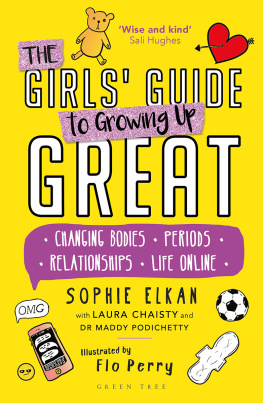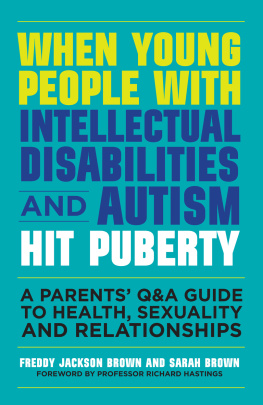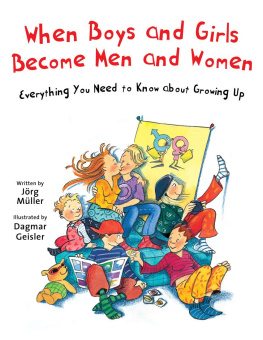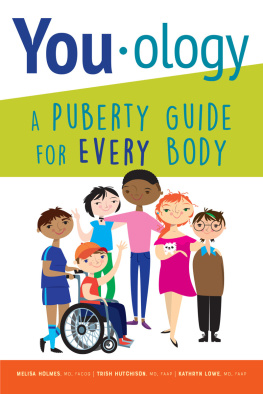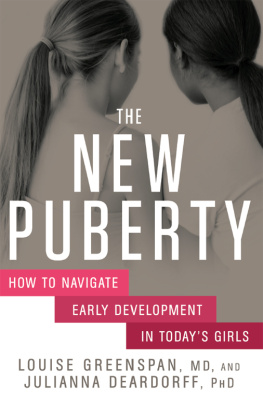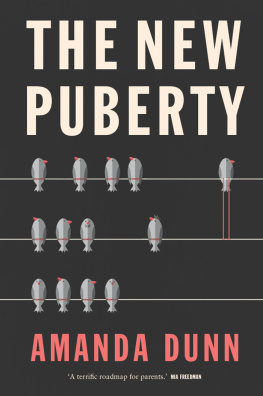Puberty, Sexuality, and the Self
Published in 1996
by Routledge
711 Third Avenue,
New York, NY 10017, USA
Published in
Great Britain by
Routledge
2 Park Square, Milton Park,
Abingdon, Oxon OX14 4RN
Routledge is an imprint of the Taylor & Francis Group, an informa business
Copyright 1996 by
Routledge
All rights reserved. No part of this book may be reprinted or reproduced or utilized in any form or by any electronic, mechanical or other means, now known or hereafter invented, including photocopying and recording, or in any information storage or retrieval system, without permission in writing from the publisher.
Library of Congress Cataloging-in-Publication-Data
Martin, Karin A.
Puberty, sexuality, and the self: girls and boys at adolescence/
Karin A. Martin.
p. cm.
Includes bibliographical references.
ISBN 0415-91424-8 (hb).ISBN 0-415-91425-6 (pb)
1. TeenagersUnited StatesSexual behavior. 2. PubertyUnited
States. 3. AdolescenceUnited States. 4. Adolescent psychology
United States. I. Title.
HQ27.M37 1996
305.235dc20
96-25060
CIP
ISBN 13: 978-0-415-91425-3 (pbk)
Dedication
To
Christine Ann Martin
and
Jon Herbert Martin
ACKNOWLEDGMENTS FIRST must go to the teenagers who participated in the interviews collected here. They talked with great openness about their personal lives and were eager to help by lending their voices to this project. Similarly, many thanks to the superintendents, principals, and teachers who allowed me into their schools and helped me overcome many of the barriers to interviewing about a difficult topic like sex. Unfortunately, they must remain nameless in order to protect the anonymity of their schools and students.
Many people have helped me to shape the ideas and research in this book. Nancy Chodorow provided me with six years of mentoring and training in feminist theory and psychoanalysis that culminated in this book. Her advice, intellect, and criticisms have been invaluable. I am also grateful to Margaret
Cerullo and Maureen Mahoney for teaching me to think critically about adolescence, sexuality, and psychoanalysis.
Bob Blauner, Christina Maslach, Jane Fargnoli, Anne Sanow, and Barrie Thorne all made comments on earlier drafts of this manuscript that significantly contributed to my thinking and revisions. I am especially grateful to Barrie Thorne for a thoughtful, detailed reading of the manuscript that was critical in the final shaping of it.
I could not have completed this project without the friendship and help of Elizabeth Armstrong and Arona Ragins. Elizabeth Armstrong and I have mixed personal and academic friendship from the moment we began graduate school together. For years, we have been engaged in one long conversation about feminism, sexuality, sociology, and personal life that has deeply influenced my thinking. Her comments and advice on countless drafts of chapters have been critical to the final project. Similarly, Arona Ragins has provided me with both colleaugeship and friendship. Her criticisms of many drafts and our long discussions about teenagers have been invaluable, as has her listening, commiserating, and cheering me up when I needed it.
I also owe many thanks to my family. My brother, Jon Martin, and I had many enlightening conversations about teenage boys, and he shared the trials and tribulations of an academic project with me. I am especially grateful to my parents, Jack and Chris Martin, for encouraging me, supporting my decisions, and generally having faith in me. Finally, I could not have completed this project without the warmth, humor, intelligence, and generosity of Laurie Morgan. She made home a fun and easy place to work and play, and our endless hours of conversation about this project have shaped it immeasurably.
Contents
chapter 3 MY HAIR IS MY ACCOMPLISHMENT:
GENDER DIFFERENCES AT PUBERTY
chapter 4 I COULDNT EVER PICTURE MYSELF HAVING SEX":
GENDER DIFFERENCES IN SEX AND SEXUAL SUBJECTIVITY
chapter 5 YOU COULD JUST TAKE ME AND FLIP IT OVER:
PARENTS AND ADOLESCENT SELVES
chapter 6 YOU JUST HAVE TO BE TRUE TO YOURSELF:
GIRLS AS SUBJECTS
chapter 7 HOW GUYS APPROACH YOU AND WHAT YOUR CHOICES ARE:
LOOKING FOR SOLUTIONS
Guide
chapter 1
Adolescent Bodies and Sexuality
Young women are engaged with questions of being female";that is, who will control, and to what extent can they control, their own bodies?
Michelle Fine, Disruptive Voices
IN THE course of researching this book, as I sat with one teenage girl after another asking them to tell me about themselves, I heard over and over again lukewarm and critical self-descriptions. Some girls said they were too quiet, while others said they were too loud. Others said they were unhappy with recent decisions they had made. Some girls said they were too sensitive to others criticisms. Many girls criticized their appearances, and many girls found it difficult to describe themselves at all. Although each girl was different, some shy, some giggly, some poised, some outgoing, most shared this self-critical eye. Boys, in general, did not. Why, I wondered, do adolescent girls think so poorly of themselves?
Research documents a large drop in girls self-esteem that occurs at adolescence. Therefore, in answering the question of why girls think so poorly of themselves, I looked to adolescence and the experiences that are most transformative at adolescencepuberty and first sexfor an explanation.
Much to the disappointment of many adult women whom I spoke to about my project, I found that in the 1990s gender still profoundly shapes adolescent experiences of sexuality. For example, girls still feel shame about their adult bodies, particularly breast development and menstruation. Girls still do it to keep their boyfriends, and boys often do it so that they can go tell their friends, Yeah! Yeah!
Certainly some things are different about teenage sexuality today compared to forty, or even ten years ago. As Lillian Rubin suggests in her book on the sexual revolution, teenagers today now feel entitled to sex. Girls and boys both talk more openly than their parents did about both puberty and sex, and many school systems now provide some form of sex education. Thus, far fewer girls begin menstruating with the fear that they are bleeding to death (although this phenomenon has not disappeared entirely). Masturbation is less taboo for boys and at least sometimes acknowledged for girls. Norms about sexuality are also slightly more accepting. Girls no longer automatically become sluts because they have sex. Rather, their age, their reasons for having sex, and the context in which they have sex are judged before labeling them sluts (an admittedly small improvement). There is still, however, no parallel to a slut for boys, although girls do call some boys himbos, a clever parallel to bimbos.
Despite these changes, many old taboos, feelings of shame, guilt and fear, and gender differentiated experiences still exist and come to the forefront of adolescent life. These gendered experiences of puberty and sex affect adolescents self-worth. For girls, these experiences lead them to feel badly about themselves, and although it is not easy for boys to navigate puberty and first sex either, their selves emerge more intact. These differences are not due to different psychological or biological makeups of girls and boys, but to the gendered cultural meanings that girls and boys learn, absorb, and use to make sense of the world during puberty and their first sexual experiences.


